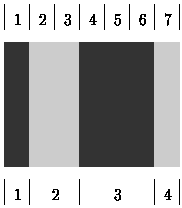当前你的浏览器版本过低,网站已在兼容模式下运行,兼容模式仅提供最小功能支持,网站样式可能显示不正常。
请尽快升级浏览器以体验网站在线编辑、在线运行等功能。
1173:Bar Codes
题目描述
A bar-code symbol consists of alternating dark and light bars, starting with a dark bar on the left. Each bar is a number of units wide. Figure 1 shows a bar-code symbol consisting of 4 bars that extend over 1+2+3+1=7 units.

Figure 1: Bar-code symbol over 7 units (see top) with 4 bars (see bottom)
In general, the bar code BC(n,k,m) is the set of all symbols with k bars that together extend over exactly n units, each bar being at most m units wide. For instance, the symbol in Figure 1 belongs to BC(7,4,3) but not to BC(7,4,2).
Figure 2 shows all 16 symbols in BC(7,4,3). Each `1' represents a dark unit, each `0' a light unit. The symbols appear in lexicographic (dictionary) order. The number on the left of the colon (`:') is the rank of the symbol. The symbol in Figure 1 has rank 4 in BC(7,4,3).

Figure 1: Bar-code symbol over 7 units (see top) with 4 bars (see bottom)
In general, the bar code BC(n,k,m) is the set of all symbols with k bars that together extend over exactly n units, each bar being at most m units wide. For instance, the symbol in Figure 1 belongs to BC(7,4,3) but not to BC(7,4,2).
0: 1000100 | 8: 1100100
1: 1000110 | 9: 1100110
2: 1001000 | 10: 1101000
3: 1001100 | 11: 1101100
4: 1001110 | 12: 1101110
5: 1011000 | 13: 1110010
6: 1011100 | 14: 1110100
7: 1100010 | 15: 1110110
Figure 2: All symbols of BC(7,4,3)
Figure 2 shows all 16 symbols in BC(7,4,3). Each `1' represents a dark unit, each `0' a light unit. The symbols appear in lexicographic (dictionary) order. The number on the left of the colon (`:') is the rank of the symbol. The symbol in Figure 1 has rank 4 in BC(7,4,3).
输入解释
Your program is to read from standard input. The first line contains the numbers n, k, and m (1 <= n,k,m <= 33). On the second line is a number s (0 <= s <= 100). The following s lines each contain some symbol in BC(n,k,m), represented by '0's and '1's as in Figure 2.
输出解释
Your program is to write to standard output. On the first line your program should write the total number of symbols in BC(n,k,m). On each of the s following lines, it should write the rank of the corresponding symbol in the input.
输入样例
7 4 3 5 1001110 1110110 1001100 1001110 1000100
输出样例
16 4 15 3 4 0
最后修改于 2020-10-29T05:54:42+00:00 由爬虫自动更新
共提交 0 次
通过率 --%
| 时间上限 | 内存上限 |
| 1000 | 10000 |
登陆或注册以提交代码